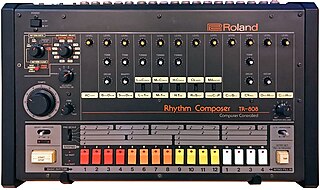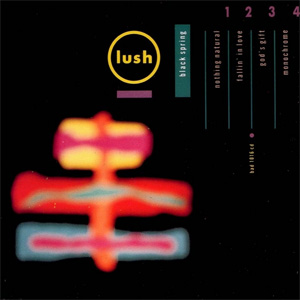Related Research Articles

A drum kit is a collection of drums, cymbals, and sometimes other auxiliary percussion instruments set up to be played by one person. The drummer typically holds a pair of matching drumsticks, and uses their feet to operate hi-hat and bass drum pedals.
Roland Octapad is a range of MIDI electronic drum percussion controllers produced by the Roland Corporation.

Roland Corporation is a Japanese multinational manufacturer of electronic musical instruments, electronic equipment, and software. It was founded by Ikutaro Kakehashi in Osaka on 18 April 1972. In 2005, its headquarters relocated to Hamamatsu in Shizuoka Prefecture. It has factories in Malaysia, Taiwan, Japan, and the United States. As of December 2022, it employed 2,783 people. In 2014, it was subject to a management buyout by its CEO, Junichi Miki, supported by Taiyo Pacific Partners.

A drum machine is an electronic musical instrument that creates percussion sounds, drum beats, and patterns. Drum machines may imitate drum kits or other percussion instruments, or produce unique sounds, such as synthesized electronic tones. A drum machine often has pre-programmed beats and patterns for popular genres and styles, such as pop music, rock music, and dance music. Most modern drum machines made in the 2010s and 2020s also allow users to program their own rhythms and beats. Drum machines may create sounds using analog synthesis or play prerecorded samples.

Digital music technology encompasses digital instruments, computers, electronic effects units, software, or digital audio equipment by a performer, composer, sound engineer, DJ, or record producer to produce, perform or record music. The term refers to electronic devices, instruments, computer hardware, and software used in performance, playback, recording, composition, mixing, analysis, and editing of music.
A music sequencer is a device or application software that can record, edit, or play back music, by handling note and performance information in several forms, typically CV/Gate, MIDI, or Open Sound Control, and possibly audio and automation data for digital audio workstations (DAWs) and plug-ins.

The Roland TR-808 Rhythm Composer, commonly known as the 808, is a drum machine manufactured by Roland Corporation between 1980 and 1983. It was one of the first drum machines to allow users to program rhythms instead of using preset patterns. Unlike its nearest competitor at the time, the more expensive Linn LM-1, the 808 generates sounds using analog synthesis rather than by playing samples.
General MIDI is a standardized specification for electronic musical instruments that respond to MIDI messages. GM was developed by the American MIDI Manufacturers Association (MMA) and the Japan MIDI Standards Committee (JMSC) and first published in 1991. The official specification is available in English from the MMA, bound together with the MIDI 1.0 specification, and in Japanese from the Association of Musical Electronic Industry (AMEI).

An electronic keyboard, portable keyboard, or digital keyboard is an electronic musical instrument based on keyboard instruments. Electronic keyboards include synthesizers, digital pianos, stage pianos, electronic organs and digital audio workstations. In technical terms, an electronic keyboard is a synthesizer with a low-wattage power amplifier and small loudspeakers.

Beatboxing is a form of vocal percussion primarily involving the art of mimicking drum machines, using one's mouth, lips, tongue, and voice. It may also involve vocal imitation of turntablism, and other musical instruments. Beatboxing today is connected with hip-hop culture, often referred to as "the fifth element" of hip-hop, although it is not limited to hip-hop music. The term "beatboxing" is sometimes used to refer to vocal percussion in general.

The Roland TR-909 Rhythm Composer, commonly known as the 909, is a drum machine introduced by Roland Corporation in 1983, succeeding the TR-808. It was the first Roland drum machine to use samples for some sounds, and the first with MIDI functionality, allowing it to synchronize with other devices. Though a commercial failure, it influenced the development of electronic dance music genres such as techno, house and acid house.
Tadao Kikumoto is Roland's senior managing director and head of its R&D center. He designed the TB-303 bass synthesizer and the TR-909 drum machine. He was also the chief engineer of the Roland TR-808 drum machine.
Ikutaro Kakehashi, also known by the nickname Taro, was a Japanese engineer, inventor, and entrepreneur. He founded the musical instrument manufacturers Ace Tone, Roland Corporation, and Boss Corporation, and the audiovisual electronics company ATV Corporation.

The Roland TR-505 rhythm composer is a drum machine and MIDI sequencer released by Roland Corporation in 1986. It hails from the same family of drum machines as the Roland TR-909, TR-808, TR-707, TR-626 and TR-606. The drum kit includes basic rock drum sounds similar to those of the TR-707, plus a complement of Latin-style drum sounds similar to those of the TR-727

The R-8 Human Rhythm Composer is an electronic drum machine introduced in 1989 by Roland Corporation, using PCM voices. The R-8 features velocity- and pressure-sensitive trigger pads, and the ability to create loops of beats. The device has eight individual outputs, 12-voice polyphony, and four-part multitimbral MIDI.

The Roland JV-1080 is a sample-based synthesizer/sound module in the form of a 2U rack. The JV-1080's synthesizer engine was also used in Roland's XP-50 workstation (1995). Due to its library of high-quality sounds and multi-timbral capabilities, it became a mainstay with film composers.

The Roland TR-707 Rhythm Composer is a drum machine released by Roland Corporation in 1985.

Black Spring is the third extended play by the English alternative rock band Lush. It was released on 7 October 1991 on 4AD. The opening track, "Nothing Natural", was released as a single with the B-side "God's Gift". Several other songs were included on the EP, including a cover version of "Lady" by Dennis Wilson.
The Roland DDR-30 "Alpha Drum" is a digital PCM drum module built by Roland, in early 1985. It was introduced during 1985 Summer NAMM industry trade show in New Orleans.
The Korg DRM-1 Digital Rhythm module built by Korg, in late 1987. It was introduced during 1987 Summer NAMM industry trade show in Chicago.
References
- ↑ "Roland R-5 - Specifications, pictures, prices, links, reviews and ratings".
- ↑ "Roland R-5". Audiofanzine (in French). Retrieved 2018-06-20.
- ↑ Lord, Nigel (July 1989). "Roland R5 (MT Jul 89)". Music Technology (Jul 1989): 14–16. Retrieved 2018-06-20.
- ↑ "Roland R-5 Human Rhythm Composer". Encyclotronic. Retrieved 2018-06-20.
- ↑ Berenyi, Miki (2022). Fingers Crossed: How Music Saved Me From Success. London, UK: Nine Eight Books. pp. 228–229. ISBN 978-1-7887-0555-4.
- ↑ "Bis-We're all fighting over the keyboard". mtv.com.